Do you have a gun that’s a little worse for wear? How about a gun you inherited that, truth be told, is really just a hunk of junk? Have you ever perused the racks of cheap, worn-out police trade-ins at your local shop and wondered if you could fix one up?
Well, the answer to all of those problems is a little bit of imagination and some Cerakote.
A little while ago I was talking to an old friend about our time spent in CMP competitions. We were prattling on about all the same things we talked about for years, just as if we had never discussed them in our lives.
We came to the point in that conversation where we began to lament the lack of good surplus guns out there these days. The discussion eventually veered off onto the process of rebuilding a 1903 A3 Springfield rifle that had, at one point, been disabled and turned into a drill rifle.
“You can’t Parkerize the area around the magazine cutoff. The welds make it so that you can’t do it.”
I nodded, as this was a primary reason I had not tried a project like that. “Yeah, I know. I wish it would be more feasible. I bet you could get a coating that would work. Cerakote would work, I’ve heard.”
“Cerakote? Son, have you been drinking curbwater? There’s something wrong with your brain if you think a coating like that belongs on a classic rifle.”
I thought on that for a while in regard to a rifle restoration project I had been kicking around. For a competitor like me, it would be nice to have a waterproof and durable finish on a rifle that will likely see plenty of rain, mud, and sweat. I eventually suspended the 1903 rebuild project and began prepping for other articles.
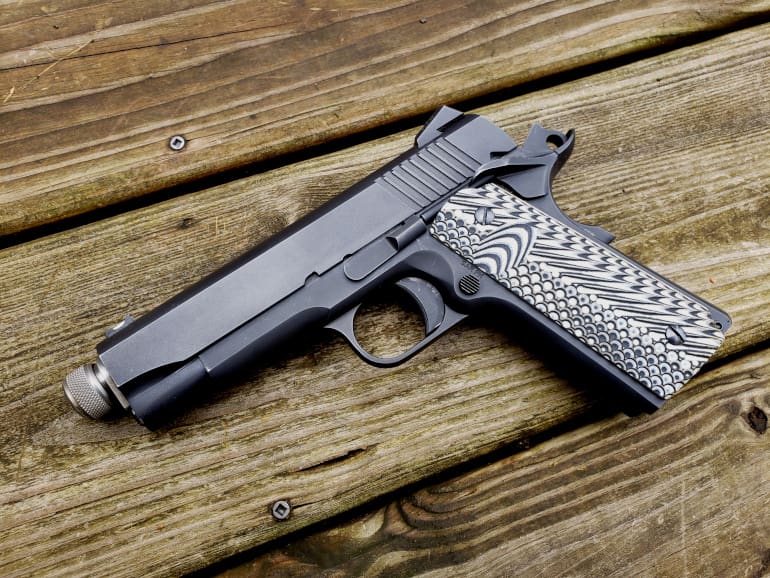
A short time later I decided to get out the Brownells 1911 project build I did here earlier this year and took it to the range for some fun. (You can read those articles here Part One and here Part Two for a complete list of the parts I got from Brownells.)
While the gun works fine, the exterior finish always bothered me a little. I mucked up a number of things when I was building it due to my lax placement of rotary tools and sandpaper. Needless to say, the gun was ugly and I had no affection for it as a result.

I decided that something had to be done and I gathered it up along with another gun that has appeared off and on over the years on TTAG: my blue-gripped Smith & Wesson J-Frame.
This gun has seen a punishing number of rounds — something in the neighborhood of 20,000 or so — and had been carried frequently. It was in what I could only call poor condition. Most of the finish was bare metal and it had an overall tired look about it.

I began looking for a place that could do something about these situations and I set my sights on the fine folks at West Michigan Cerakote.
Unlike many other companies in my area, West Michigan Cerakote is a coatings-only business. The are fully certified and were trained at Cerakote headquarters to do even the most advanced applications. They enjoy ongoing support from Cerakote and continue to train hands-on with Cerakote’s pros.
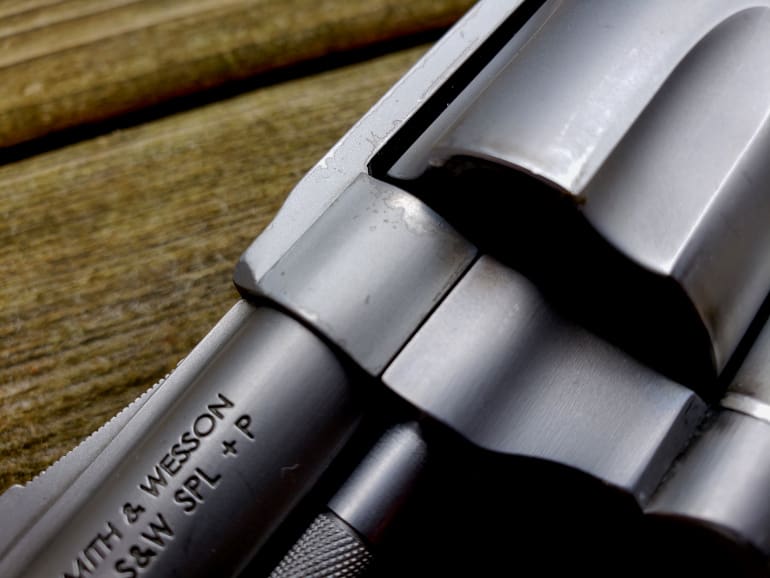
As I found out, not every Cerakote applicator is certified or trained. There’s a huge difference in consistent application as compared to work done by a non-certified shop.
Think of it this way: your wife may make a killer sandwich, but she can’t make as many exactly the same in volume as Jimmy John’s. Every Jimmy John’s has the same equipment and delivers the same consistent, reliable product.
West Michigan Cerakote uses the same equipment as the Cerakote company does so the results will be identical to what the manufacturer intended.
West Michigan Cerakote is one of the only multi-industry Cerakote applicators in the Midwest. They work with several other industries including automotive. Guns are a large part of their business, but the Cerakote material is so versatile it can be used to coat any surface including polymers. Yes, you can have your GLOCK or Ruger frame coated without causing it to melt, contrary to some opinions I have heard.
So what does getting your gun coated look like from a practical standpoint? I hear all the time that it’s a six-month ordeal and it’s not worth it. Well, a gunsmith that also does coatings may take forever (as most gunsmiths seem to). West Michigan Cerakote boasts a 2-4 week turnaround.
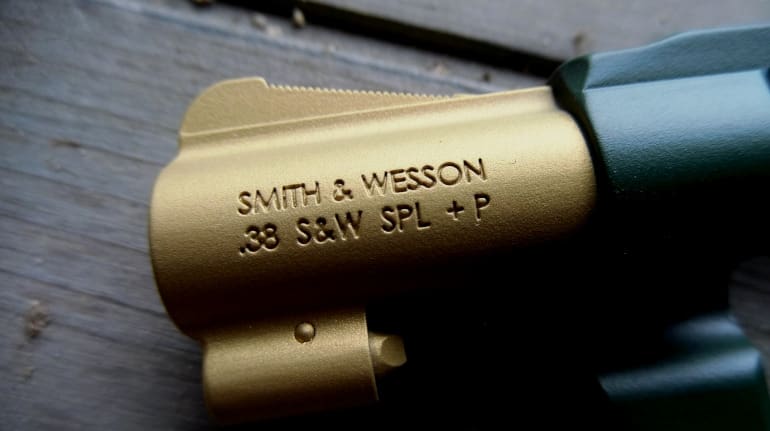
WMC also gives a lifetime guarantee against cracking, chipping, and peeling. This does not cover holster wear and abrasion in the event you decide to see how well your gun enjoys being tossed on concrete.
I got my two completely stripped guns here only two weeks to be processed. It will take longer if they have to disassemble your gun for you.
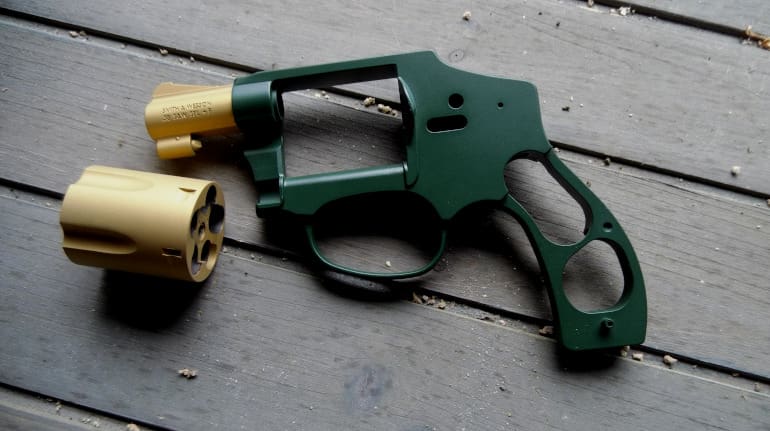
I decided to go with two totally different surface coatings on my guns. This was done for several reasons, both practical and cosmetic.
Most of the rifles and shotguns sent in to WMC are sent in for cosmetic and protective upgrades. Handguns are typically sent for what amounts to repair of worn surfaces and coatings and are rarely purely cosmetic.
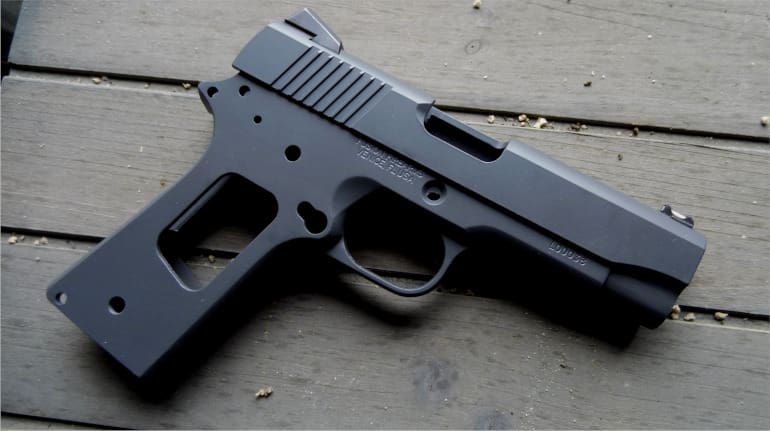
You have several options when it comes to Cerakote. The first isn’t featured in this article. The C Series coating is rated for high temperature work. That coating is typically applied to automotive parts, barrels for high-volume competition rifles, machine guns, and suppressors.
H Series is what I had applied to the revolver in this article. This is the most common type of Cerakote and is the kind you see in artistic work. You’ve all seen rifles covered in everything from American flags to guns made to mimic the colors of Star Wars’ Boba Fett and his armor. Literally anything is possible and is totally up to you.
The H Series has the most colors available and has adjustable amount of sheen. My revolver displays Gold (H-122) and Jesse James Eastern Front Green (H-400).
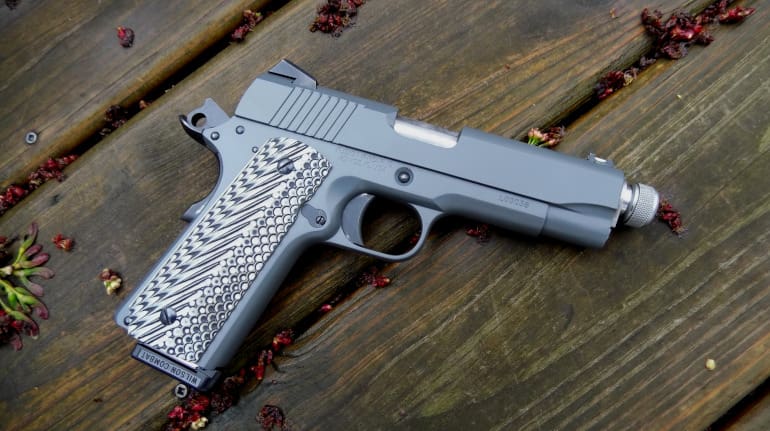
The Elite Series is what was applied to my 1911. This coating is twice as hard and half as thick as other Cerakote products. The Elite Series is however only offered in a few finishes and there is only one sheen level available, which is satin.
I went with this finish for the 1911 because it’s a top-of-the-line finish for hard-use guns. This 1911 will be making numerous appearances in the months to come and will be used in testing ammunition, new 1911 parts, and in matches so the Elite finish was a no-brainer.
The color used on my gun is Elite Concrete (E-160).
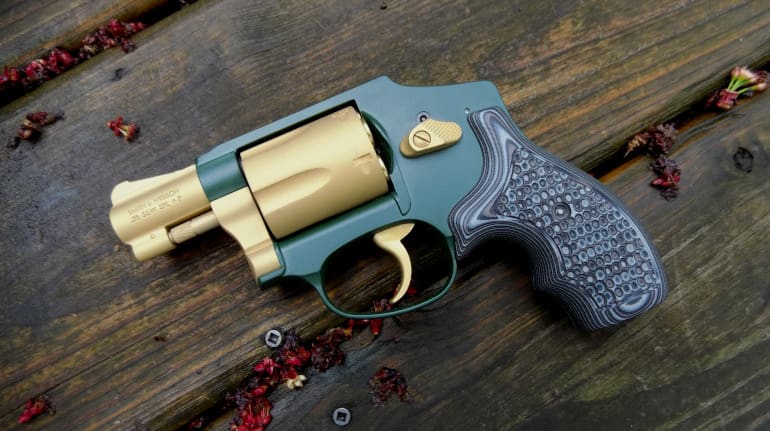
Care must be taken when reassembling your freshly-finished gun. Although the finish is thin, it may be thick enough to give you problems in some areas. I had to remove a slight amount of material around the hammer pin on my revolver, but that was pretty much it.
The 1911 reassembled instantly and without issues. It’s slicker than it was before, which I am very excited about.
If you are the lucky owner of a beat-to-hell piece gun, you can sleep easy knowing that you can get your beater made pretty and back in your hands in just a couple weeks from the folks at West Michigan Cerakote. You’ll have a much greater amount of pride in your gun knowing that you’ve made it even more yours.
My opinion changed on my 1911 instantly. I resented the gun for being so damn hard to build and how bad it looked to me, but now I can’t stop looking at it. The next time you pass a $300 police trade it, perhaps don’t see it as a bargain bin special. Look at it as a potential blank canvass for your next Cerakote project.




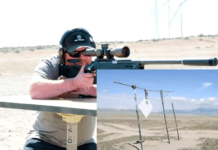
Creosote, no Thanx. A bunch of us got creosote burn carrying fresh railroad ties. How about just painting it black, that’s what a duck hunter friend does with his shootgunns
Reread “Cerakote” not “Creosote”. Not the same thing
How do you even turn your computer on?
Josh, I don’t know where in Michigan you live, but there are a number of places that do Cerakoting for firearms. If you are in mid-Michigan, I recommend Men of Arms in Charlotte. There are others on the east side. I assume you live on the left side of the mitten.
Nope.
NP3 from Robar after a good bead blast may be worth the expense.
Cerakote kinda sucks.
I had Robar work over a Colt Series 70 Combat Government Model. Including NP3 finish. Best finish I ever had applied to a handgun and I’ve tried pretty much all of them.
Nope, I purchased a new Sig 226 which had been NP3 finished. Now mind you, the Sig frame is alloy. After just a few months, I noticed pitting on the grip frame. The dealer I purchase it from just said “tough luck”. I’m guessing, just like black oxide (bluing), NP3 uses salts in the process and they did not neutralize the salts, causing the pitting. I removed some of the pitting, but not all. Still have the 226, still shows some of the pitting but it is now neutralized and doing fine. Don’t know who did the original NP3, but I’ll have nothing to do with NP3 again.
Marty. NP3 is a Teflon impregnated hard chrome. It doesn’t rust. Also, it’s proprietary to Robar. Robbie Barkman is as good they come. If your Sig suffered pitting I doubt it was NP3. If it was I believe Robar would have made it right. I suspect the problem is with the horse’s ass you bought the pistol from.
Gadsden, I have no idea, so you could very well be correct. I bought it from a LE supply store and it was new. Have no idea who did the NP3,but I think it was a fairly new process at the time back in the mid 80’s. Still an excellent pistol and I love it.
“… I eventually suspended the 1903 rebuild project and began prepping for other articles….”
I have one disassembled waiting until I get to it. I would like to have stock refinished but that would remove all the markings probably….nothing special rare about rifle just old. dunno what I will do.
Is there a lubrication recommendation for Cerakote on high friction area like slide rails and guides?
You can parkerize over welds if the welding is done with that in mind.
If it wasn’t done that with such a follow up process in mind then you have to reheat the metal along the weld seam and retreat the metal. This is by preheating, then full on heating, I’d use a TIG torch for that because 1) It’s the best form of welding and 2) precise enough for this kind of work and then letting the item air cool or cool in sand.
May take a couple of passes but it will get rid of the strange effects in the coating. Provided of course that whoever’s welded it used the same type of steel in the weld that the rifle is made of. If they didn’t do that then you need to remove the weld and put in another with the right heating methods.
My well worn Kel Tec P40 had some rust starting on the slide. Disassambled and cerakoted the slide…receiver is plastic. Battleship grey satin finish looks great and no more rust.
It’s still not a Sig, but gets carried dang near every day. Reliable and not beautiful, but now un-ugly.
The 1911 looks ok, but My God what did you do to the j-frame?
My 437 looked worn also, but I took off the clear and polished it, and looks like a tuxedo gun. But green and yellow, really? Truly the Jimmy Johns of gun finishes.
How much does a cerakote job run ,say like that 1911 what did that set you back ?
Right? Some important information is missing here.
Usually a single color from a reputable place is going to be $150-$200~. More colors, duals (like the revolver here) be more.
Thanks Jon. I had in mind to do an old slightly rough S&W N frame, but the Cerakote cost actually exceeds the price I paid for the gun…. so back to square one.
I have a used M&P22 Compact and used some leftover Duracoat to coat the slide. Does that count?
Following. Got a 1911 ugly as my ex wife. That 1911 in the article looks great.
Just like your wife can make a sandwich as good as or better than Jimmy John’s, you can do a Cerakote job yourself that is as good as any professional finisher.
Cerakote c air cure is childishly easy to apply. A cheap pancake air compressor from Harbor freight is $40 with the water trap and a cheap badger airbrush that’s another $20. One bottle of Cerakote c with the paper filter you strain it through is $35 from Brownells.
And old gun with a worn finish needs the finish removed either by sandblasting or simple hand sanding.
Degrease exactly according to the cerakote instructions and spray.
Practice on an ammo can or a Tumbler first. One little bottle will finish at least 4 pistols.
Air cure Cerakote can be applied to optics and is plenty hard, you cannot scratch it even with a key.
If you want the ultimate in hardness, use the Cerakote H oven dry.
Just as easy to apply, when you are done bake in the oven exactly according to the directions. I Use my home oven when my wife is out.
Camo patterns are just like a child’s project, apply stencils between coats and do a overnight air cure Cerakote (c) or partial oven cure (h) between coats.
You will be amazed at the factory type finish you can do yourself. Careful because Cerakoting is addicting!
Well…I guess there is no one around here that is certified and bonafide.
I never seen a ceracoted gun, factory or otherwise, that I would like to own.
Maybe its just preference of finish, but every one I’ve seen ( with use) looks like a cheap BB gun finish from the 60s. Chipping around the edges and where seams meet.
When I see the factory or shop offerings of new arms that have been ceracoted, I always think everything looks good when it’s new.
Look into Blown Deadline, then you’d be lying if you repeat those words.
BDL isn’t human. It’s a machine an alien created. No human is that good.
I’ve a colt official police 38 that has some kind of black coating I’m sure isn’t original. It’s coming off in the hammer area where the cartridge is struck. I’m not worried about preserving the value of a 250 dollar revolver but I’d like to have it refinished.
I’m going to see if the finish can be chemically removed and I’ll look into this finish.
Yep they’ve done two of my guns always top notch service..
Buffman-RANGE says:
May 4, 2019 at 20:16
Yep they’ve done two of my guns always top notch service..
Reply – Whose “they’ve” ??
Sorry that would help. West Michigan Cerakote is the company who’s done my two SBS projects.
Was it intentional that the piece you pack is in Packer green and gold?
No ceracote on my carry guns.
Looks great out of the box but Wears off fast and with every use. Never understand why Wilson uses it.
Hard chrome by either Metalife or Armoloy penetrates the pores of the metal and leaves no build up to reduce tolerances and is the best but butt ugly (looks like stainless steel) and only coats the outside of the gun not the inside so no rust protection on the inside. Electrolysis Nickle is more pleasing to the eye than hard chrome and it coats inside as well as outside to prevent rust but can reduce tolerances and is softer than hard chrome which means it will scratch more easily than hard chrome. It also will coat the inside of the barrel which is a big plus for rust resistance and neglect which is the hallmark of most gun owners who seldom maintain or care for their firearms.
Two words: Krylon Gold.
I cerekoted my 100+ year old colt pocket hammerless.
I took a Savage 500 12 Ga that I believe was older Police weapon that I paid $50 for. Had someone Cerakote it and replaced the stock. It looks brand new and works GREAT
Excellent article
And 100% on target about buying the $300 police trade in and getting it refinished.
I’ve done that a couple of times, and well worth the investment.
Those came out very nice.
I think one of the main reasons people hesitate to spend money on Cerakote is because they see their buddy’s cousin’s brother’s gun that was done by a non-certified applicator, or worse, someone’s do-it-yourself home-bake-garage job. My first Cerakote job was done by someone who wasn’t certified. The coating flaked off, scratched, and was a complete waste of money. After some time I gave Cerakote another shot but with a certified shop. WOW. World of difference. There are so many places the application process can go wrong and having someone trained by the manufacturer to apply it made a world of difference; especially when they are able to talk about the exact science of how/why it works/fails…compared to Joe Schmoe who “followed the directions” and wonders why the coating didn’t last.
Comments are closed.